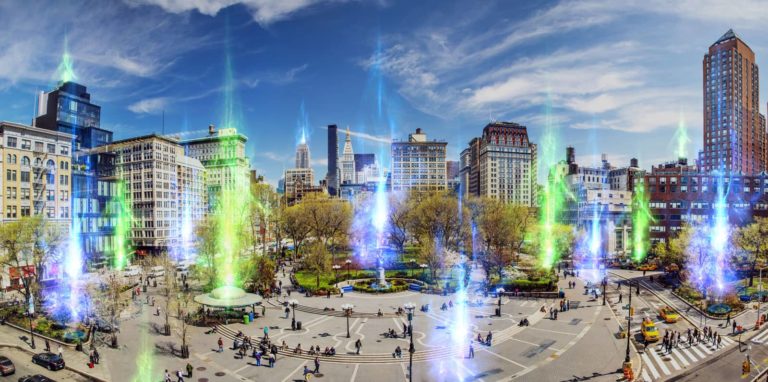
One of AR’s most opportune sub-segments is what we call “AR as a service.” Also known as AR building blocks, these enabling technologies work towards democratizing advanced AR capability for developers. One byproduct of such endeavors is to push AR collectively forward.
Niantic is the latest company to go down this road. Though known best for its breakout hit Pokémon Go, its true fate may be as an AR platform. Enter Niantic Lightship, which turns Pokémon Go’s architecture into a platform on which others can build geospatial AR experiences.
And the timing could be right, as geolocal AR will be an increasingly-opportune area that represents AR’s metaverse. In other words, the metaverse is often discussed in VR terms (or multiplayer gaming), but its AR counterpart will materialize through geo-relevant AR experiences.
If this sounds familiar, it’s aligned with a guiding principle for AR’s future: the AR Cloud. As AR enthusiasts know, this is a framework in which data is anchored to physical places to enable AR devices to trigger the right experiences. This is the opportunity that Lightship unlocks.
Core Ingredients
Going deeper, Lightship packages up Pokémon Go’s architecture and load-tested capabilities into a geospatial AR experience creation engine. This specifically takes form in an open SDK. More accurately, it’s classified as an augmented reality developer kit, or ARDK.
In that form, Lightship will enable app developers to build experiences on top of the infrastructure that Niantic spent years building the hard way. This includes things like scaling up to surges in user behavior, mapping proficiency, location intelligence, UX design, and game mechanics.
More specifically, Niantic lists three core ingredients for Lightship ARDK:
Real-time Mapping through advanced Meshing combines smartphone camera technology with a neural network, to map an environment in real-time into a mesh of repeating tessellated triangles, resulting in a machine-readable representation of the physical world. In the Niantic Lightship ARDK, meshing makes “physics” possible for virtual objects.
Semantic Segmentation improvements in the beta distinguish between varied characteristics of a space — ground, sky, a building, etc. — so that virtual objects can look, feel and move in realistic ways. Lightship can automatically segment different natural outdoor objects in a scene, enabling AR content to interact with specific surfaces.
More robust Multiplayer functionality allows developers to benefit from co-localization, networking, and synchronization improvements, enabling immersive multiplayer experiences where up to eight players can share the same AR experience in the same real-world space at the same time. Peer-to-peer messaging and back-end server features are built in, so developers can focus on sculpting the shared experience players will have. While this kind of content anchoring is currently ephemeral, we know that long-term virtual content anchoring will enable developers to build future AR experiences that persist.
Planet Scale
Another Lightship ARDK advantage could be one not listed above: scale. The world is a big place so far-flung spatial maps could require a federated approach. By lowering barriers for developers, Lightship’s resulting scale could engender a collective AR cloud that builds over time.
Altogether, this will contribute to Niantic’s vision for “planet-scale AR.” The idea is to have meaningful interactions with the real world on a global scale. And this will importantly apply beyond geospatial gaming – including potential use cases for social interaction and local discovery.
Back to the concept of “AR as a service,” Lightship’s value will lie in its position as an AR enabler and accelerant. But notably, it achieves this in a way that’s analogous to one of the biggest enablement tools the tech world has ever seen: Amazon Web Services (AWS).
In other words, just like AWS, Niantic built its engine primarily to power its own product. But then realized it can be its own platform. As such, Lightship empowers legions of startups to add their own levels of creativity to its market-validated geospatial AR foundation.
And that tracks to good business and altruism – both of which are endemic to Niantic’s mission. Now that it’s mastered the art of geo-local AR, it’s logical to productize the whole thing as a platform. That way, developers can run with it and build apps that take AR to the next level.
Find out more about Niantic Lightship during its live virtual launch event on November 8.



